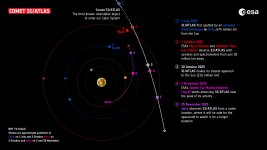Wagerallsports
Wagerallsports
Administrator
Staff member
- Joined
- Mar 6, 2018
- Messages
- 75,958
3I/ATLAS is anomalously massive
Fresh data suggests it weighs at least 33 billion tons with a nucleus over 5 km wide. To put that in perspective:
Earth’s Moon: ~7.35 × 10¹⁹ tons, ~3,474 km across
3I/ATLAS: ≥33 × 10⁹ tons, >5 km across
That makes 3I/ATLAS about 2 trillion times less massive than the Moon, and roughly 700 times smaller in diameter. It is enormous for an interstellar visitor, yet still tiny compared to planetary bodies.
Here’s why this matters:
Over 4,000 observations from 227 observatories show no detectable non-gravitational acceleration. Even while venting CO₂ and H₂O, it isn’t being nudged off course — meaning it’s incredibly massive.
Loeb, Cloete & Veres’ analysis confirms: ≥33 billion tons minimum mass.
Models predict we should see tens of thousands of smaller interstellar rocks before spotting one this size — yet we didn’t. Either our models are wrong, or 3I/ATLAS isn’t just debris.
Its nickel-rich, iron-poor spectrum is unusual — more like manufactured alloys than natural rock.
Its orbit is perfectly aligned with the ecliptic. The odds of a random interstellar body sliding into that plane? ~1 in 500. That alignment looks more like targeting than chance.
Upcoming checkpoints:
Oct 3, 2025 — Mars flyby (HiRISE could image the surface).
Mar 16, 2026 — Jupiter encounter (Juno may capture more detail).
If it maneuvers, propulsion is the only explanation.
Right now, the evidence says:
Massive — 33 billion tons
Large — >5 km across
Anomalous chemistry — nickel without iron
Suspicious orbit — perfectly ecliptic
Fresh data suggests it weighs at least 33 billion tons with a nucleus over 5 km wide. To put that in perspective:
Earth’s Moon: ~7.35 × 10¹⁹ tons, ~3,474 km across
3I/ATLAS: ≥33 × 10⁹ tons, >5 km across
That makes 3I/ATLAS about 2 trillion times less massive than the Moon, and roughly 700 times smaller in diameter. It is enormous for an interstellar visitor, yet still tiny compared to planetary bodies.
Here’s why this matters:
Over 4,000 observations from 227 observatories show no detectable non-gravitational acceleration. Even while venting CO₂ and H₂O, it isn’t being nudged off course — meaning it’s incredibly massive.
Loeb, Cloete & Veres’ analysis confirms: ≥33 billion tons minimum mass.
Models predict we should see tens of thousands of smaller interstellar rocks before spotting one this size — yet we didn’t. Either our models are wrong, or 3I/ATLAS isn’t just debris.
Its nickel-rich, iron-poor spectrum is unusual — more like manufactured alloys than natural rock.
Its orbit is perfectly aligned with the ecliptic. The odds of a random interstellar body sliding into that plane? ~1 in 500. That alignment looks more like targeting than chance.
Upcoming checkpoints:
Oct 3, 2025 — Mars flyby (HiRISE could image the surface).
Mar 16, 2026 — Jupiter encounter (Juno may capture more detail).
If it maneuvers, propulsion is the only explanation.
Right now, the evidence says:
Massive — 33 billion tons
Large — >5 km across
Anomalous chemistry — nickel without iron
Suspicious orbit — perfectly ecliptic

